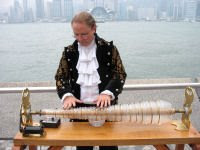
This morning I played a piece by Russian composer Vladimir Martynov called
Come In!
Here is what Martynov wrote in the liner notes, translated from the Russian by Elisabeth Konovalova.
One ancient hermit said to his disciple: "Strive to enter the inner cell of your soul and there you will behold the heavenly cell. Both are one: you enter them by the same door. The staircase to Heaven is inside you: it exists secretly in your heart."
And it is true:
Our whole life is but an attempt to find this miraculous entrance.
All our deeds are but a timid knocking on this mysterious door.
All our hopes are to hear, one day, perhaps, a voice that would respond: "Come in!"
For it is said: "Knock and you will be let in."

You might be intrigued by some of the reviews on amazon, where you can also listen to samples of the work if you didn't catch it this morning. It's from a cd called Silenco featuring violinist Gidon Kremer and Kremerata Baltica.
























































































